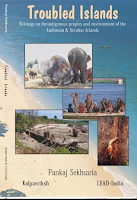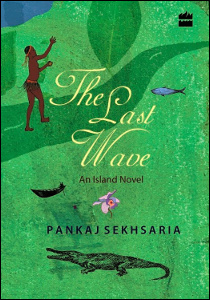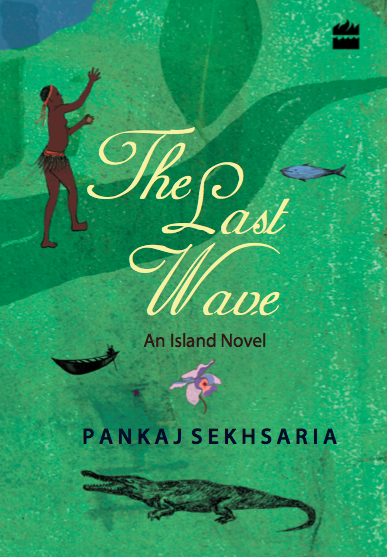A Heat Rash,
Excerpt from The Last Wave
Chp. 20, Pgs 223-226
She had already pushed past the man in khaki. ‘And what are you standing there for?’ she said, pointing at Harish, ‘Come with me.’ She looked at policeman and said nonchalantly, ‘My husband.’
‘Really? I didn’t know you were married.’ Pintu jabbed his elbow into Harish’s ribs. Harish walked through quickly and across to Seema. They went straight to the doctor’s cabin.
‘Hello, Doctor,’ Seema said politely. ‘How are you?’
‘Hello, Seema,’ he said, mildly surprised. ‘And how are you?’
‘I was passing by, and thought I’d see you,’ Seema replied, ‘just to
get checked.’
‘Not needed. Not needed. You are fine.’
‘If you say so, doctor. And what is this commotion outside?’
Seema asked casually.
‘Just curious onlookers – they have nothing better to do anyway. I was telling you about those Jarawa boys. One of them was admitted here last night with high fever.’
He noticed Harish, who had been standing to the side. ‘This is . . .?’ he asked Seema.
‘This is Harish, our colleague at the Institute.’
‘Hello, Harish. Please sit.’
‘Thank you. Is it serious?’ Harish asked, ‘This fever?’
‘No. I don’t think so. We won’t keep him here for very long. It is
not good for him. I am giving him some medicine and will send them back tomorrow.’
‘But,’ Seema queried, ‘will he be okay?’
‘Well, what can I say? See, these are orders from the top – from Port Blair. They don’t want the Jarawas here for very long. It’s, in any case, not good for them here – they can easily get an infection of some kind. See, I’m not supposed to be telling you all this.’
‘You think,’ Seema asked tentatively, ‘that we can see him?’
‘Actually, that would not be allowed, but come, you can have a look quick.’
Seema and Harish quickly followed Dr Bandopadhyay out of his room and stopped at the door of the adjoining ward, which he entered. It held four beds; three were empty and the one farthest away was occupied by a little Jarawa boy, about six years old. He looked extremely tired, had a runny nose and a rash seemed to have appeared on his forehead.
Harish noticed from the corner of his eye that there was someone else in room as well, sitting quietly in the corner to the right. Harish turned to look and recognized him immediately. The same glare pierced through him, the same anger that had knocked him out only a few months ago. This was the same Jarawa man he had exchanged glances with on the afternoon glass bangles had been slipped over a Jarawa wrist.
He was staring straight at Harish, and like before, Harish could lock eyes with him for only a few moments.
‘Let’s go,’ Seema tapped Harish’s shoulder as she turned and followed the doctor back into his cabin.
‘What do you think it is, Doctor?’ Seema asked.
‘It is some kind of heat rash, nothing more.’ The tone of the answer was a clear indication to the visitors that they should be on their way.
‘We should be going,’ Seema saw that their time was up. ‘And I don’t need to worry about anything, Doctor, right?’ she asked, for the sake of asking.
‘No, no. You are fine, don’t worry.’
‘I noticed,’ Seema said to Harish as they were walking back to Pintu’s house. ‘Why was that Jarawa guy staring at you so intently? It’s almost like he knows you?’
‘I don’t really know,’ Harish replied, a little lost in his own thoughts as he described to her what had happened at the jetty the last time. ‘But you know something?’ he said with a frown. ‘There was a change. That glare was the same and yet it was different. Something seems to have happened . . . I don’t know!’
They were now with Pintu who had his own speculations to offer. ‘There are two things that would interest you,’ he started, ‘Tanumei has virtually disappeared . . . No, no,’ he saw the concern on the faces of Harish and Seema, ‘nothing seems to have happened to him. From what we hear, he is still around, but somewhere deep in the forest with his band. He’s not come this side for weeks. No one has seen him for a while now. It is quite baffling.’ He paused. ‘The other thing is this fever. See,’ he said, ‘I don’t know for sure. They are all from that side – from near Middle Strait. One of the Jarawa group has now set up camp very close to the road, and this is where the news is coming from. This boy in the PHC, he is from that group. I know because I saw the man accompanying him.’ Pintu looked at Harish. ‘The tall, thin Jarawa fellow with those big, intense eyes. You remember him Harish? He was there last time too, at the jetty’. ‘Oh! Was he? These Jarawas are still quite unpredictable. This Middle Strait group more so. You will even see some of them on your way back. Definitely. They are standing by the road all the time.’
‘This is what Basu and Justice Singh were also talking about, isn’t it Harish?’ Seema was reminded of the conversation of the earlier evening, ‘The Jarawas near Middle Strait.’
‘Basu?’ Pintu asked. ‘Samaresh Basu? That crook?’
‘Yes,’ Harish said, ‘we met him in Mayabundar just yesterday.’ ‘He’s like a two-tongued snake. Says two things in the same
breath.’ Pintu clearly had a strong opinion about the man. ‘One never knows what these politicians really mean and how much to trust them. He was here last week and promised in a meeting that he would get the administration to move the Jarawa from here to some other island. Might be a good thing to do, but I wonder what Basu’s going to gain from that?’
---
Get a copy online
Flipkart - http://t.co/n7RIVcl0pC
Amazon - http://tinyurl.com/l4e75r8
Kindle - http://amzn.to/1uUq27n
 1) The Last Wave- an island novel,
published in 2014 by Harper Collins India is a story that has at its heart the
ecology, people, and history of the Andaman and Nicobar Islands. Review: http://indianexpress.com/article/lifestyle/books/troubled-waters-7/
1) The Last Wave- an island novel,
published in 2014 by Harper Collins India is a story that has at its heart the
ecology, people, and history of the Andaman and Nicobar Islands. Review: http://indianexpress.com/article/lifestyle/books/troubled-waters-7/ 2) Troubled Islands is a joint publication of Kalpavriksh and LEAD
India and was published in 2003. It is a collection of articles on the islands I
wrote i n the mainstream English media between 1998 and 2003. It has as annexures
the Shekhar Singh Report of 2002, Supreme Court orders of 2002 and eight colour
plates with pictures from the island
2) Troubled Islands is a joint publication of Kalpavriksh and LEAD
India and was published in 2003. It is a collection of articles on the islands I
wrote i n the mainstream English media between 1998 and 2003. It has as annexures
the Shekhar Singh Report of 2002, Supreme Court orders of 2002 and eight colour
plates with pictures from the island























